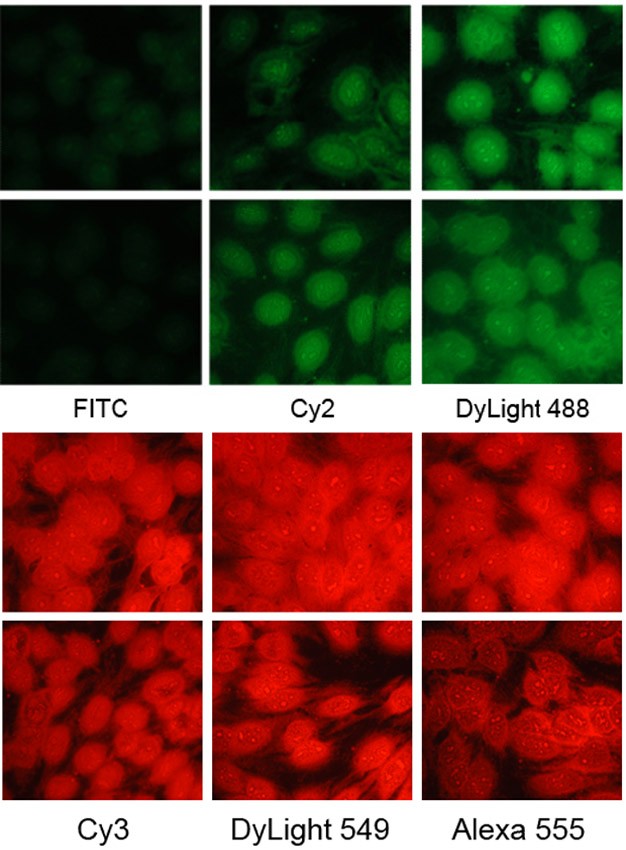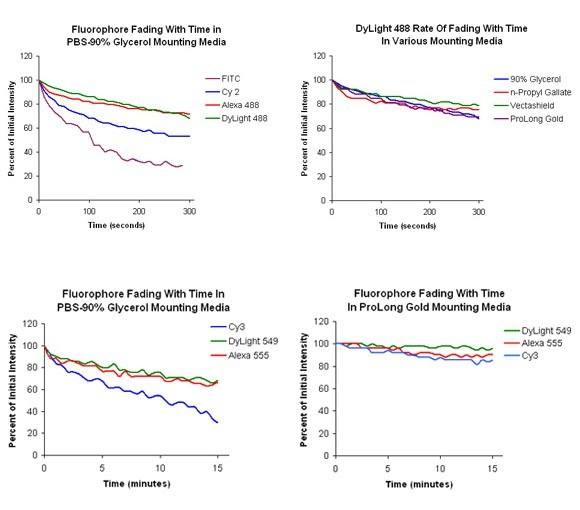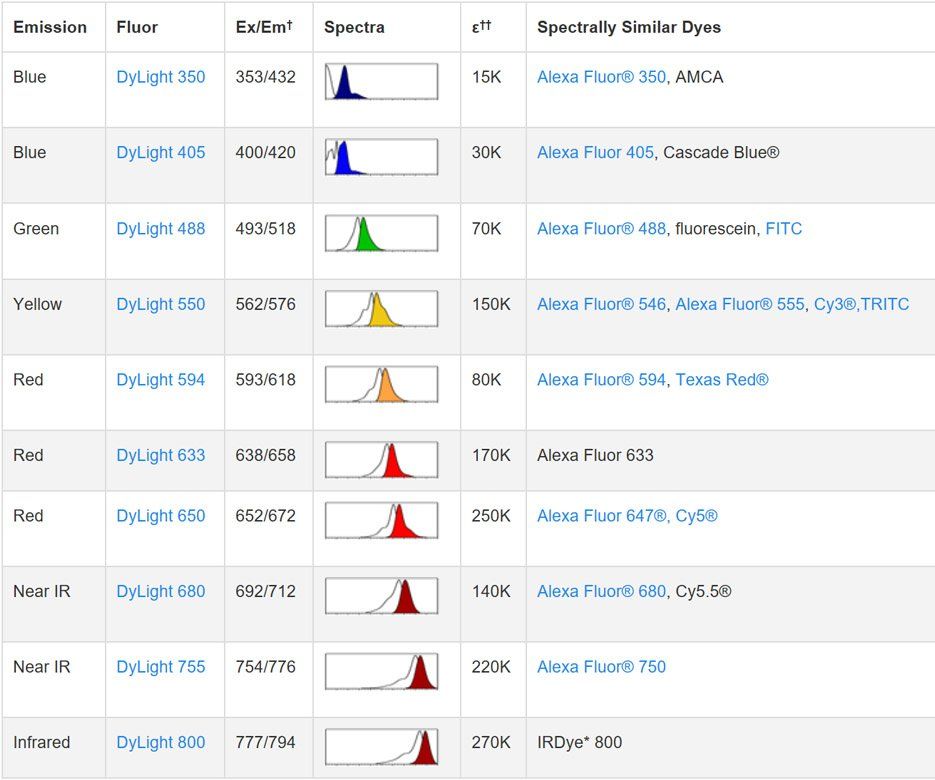| Product name | DyLight 405, Goat Anti-Mouse IgG |
| Immunogen | Mouse IgG whole molecule |
| Host | Goat |
| Reactivity | Mouse |
| Applications | FCM, ICC, IF |
| Applications notes | Optimal working dilutions should be determined experimentally by the investigator. Suggested starting 1:50-1:1000 dilutions for most fluorescent applications. |
| Clonality | Polyclonal |
| Preparation method | Affinity purified using solid phase Mouse IgG (H&L) with finally > 95% purity based on SDS-PAGE |
| Conjugate | Dylight 405 |
| Formulation | Liquid solution |
| Features & Benefits | DyLight fluorescent dyes are a new family of dyes with improved brightness and photostability). They are better than or comparable to the best fluorescent dyes from other companies). The detection level of any fluorophore-antibody conjugate depends on brightness and photostability of the dye; antibody activity, specificity, and cross-reactivity; and the optimal moles of dye per antibody). A molar saturation curve vs fluorescence intensity, antibody activity, background level, and/or other parameters has been established for each dye to optimize the level of antibody detection and minimize background). DyLight fluorescent dyes are highly water soluble and remain fluorescent from pH 4 to pH 9). |
| Storage buffer | Liquid in PBS, pH 7.4, containing 0.02% Sodium Azide as preservative, 1% BSA as stablizer and 50% Glycerol. |
| Storage instructions | Stable for one year at -20°C from date of shipment. For maximum recovery of product, centrifuge the original vial after thawing and prior to removing the cap. Aliquot to avoid repeated freezing and thawing. |
| Shipping | Gel pack with blue ice. |
| Precautions | The product listed herein is for research use only and is not intended for use in human or clinical diagnosis. Suggested applications of our products are not recommendations to use our products in violation of any patent or as a license. We cannot be responsible for patent infringements or other violations that may occur with the use of this product. |
| Background | Abbkine secondary antibodies are available conjugated to enzyme, biotin or fluorophore for use in a variety of antibody-based applications including Western Blot, ImmunoHistoChemistry, ImmunoFluorescence, Flow Cytometry and ELISA. We offer high quality secondary antibodies from goat, rabbit and donkey sources for your each application. Serum adsorbed secondary antibodies are also available and are recommended for use with immunoglobulin-rich samples. |
| Others | The antibody reacts with whole molecule mouse IgG. It also reacts with heavy chains of mouse IgG, and light chains of all other mouse immunoglobulins. It has no reactivity on non-immunoglobulin serum proteins, while it may cross-react with immunoglobulins from other species. |

Fig.1. DyLight fluorescent dyes are a new family of dyes with improved brightness. DyLight 488-antibody conjugates are brighter than Cy2 and FITC conjugates and similar in brightness to Alexa Fluor 488 conjugates. DyLight 549-antibody conjugates shows brighter influoresence than TRITC conjugates. Also, DyLight 594-antibody conjugates are noticeably brighter than Alexa 594 conjugates, and much brighter and more water soluble than Texas Red conjugates.

Fig.2. DyLight fluorescent dyes show improved photostability as well. DyLight 488 conjugates fade less than FITC and Cy2 conjugates in mounting media indicating that the DyLight 488 molecule is inherently more photostable in epifluorescence microscopes. DyLight 549 conjugates are about as photostable as Alexa 555 conjugates and slightly more photostable than Cy3 conjugates.

Fig.3. To use the DyLight Fluors with fluorescent imagers, use a spectral line of the blue laser diode for DyLight 405, a cyan (488 nm) laser for DyLight 488, a green (526 nm) laser for DyLight 550 and 594, and a red (633 nm) laser for DyLight 633 and 650. The DyLight 680, 755 and 800 fluors are compatible with laser- and filter-based infrared imaging instruments that emit in the 700 nm, 750 nm and 800 nm region of the spectrum, respectively.
Author:Zhang LJ, Xia L, Liu SL, et al Publication name:ACS Nano IF:14.29
Author:Congcong Shen, Linlin Sun, et al Publication name:International Journal of Molecular Medicine IF:2.91
Author:Zuo Y C, Xiong N X, Shen J Y, et al Publication name:Neurochemical Research IF:2.8
You must be logged in to post a review.
1.The species of antibody reactivity should be the sample species that can be matched normally after Abbkine R&D experts have passed strict scientific verification. If your sample is not within the range of reactivity, in order to improve the efficiency and results of your experiment, it is not suggested to try other species. Otherwise, it may lead to sample mismatch and affect the effect of your experiment.
2.Please aliquot the antibody received as soon as possible and store it at -20℃, avoid repeated freezing and thawing, and use it within one year.
Welcome any form of communications, and better service will be provided here.
Tell: +1-404-854-0155
Email: service@abbkine.com
Support Email: support@abbkine.com
Address: 3052 Stroop Hill Road, Apt 203, Atlanta 30303, Georgia, United States of America




Reviews
There are no reviews yet.